- Home
- Terry Pratchett
The Science of Discworld Page 15
The Science of Discworld Read online
Page 15
SIXTEEN
EARTH AND FIRE
WE DON'T KNOW IF THE EARTH IS A TYPICAL PLANET. We don't know how common 'aqueous' planets with oceans and continents and atmospheres are. In our solar system, Earth is the only one. And we'd better be careful about phrases like 'earthlike planet', because for about half of Earth's history it has not been the familiar blue-green planet that we see in satellite photos, with its oxygen atmosphere, white clouds, and everything else that we are used to. In order to get an earthlike planet, in today's sense, you have to start with an unearthlike planet and wait a few billion years. And what you get is quite different from what, only a few decades ago, we thought the Earth was like.
We thought it was a very stable place — that if you could go back to the time when the oceans and continents first separated out, they'd have been in the same places they are now. And we thought that the interior of the Earth was pretty simple.
We were wrong.
We know a lot about the surface of the Earth, but we still know much less about what's inside it. We can study the surface by going there, which is usually fairly easy, unless we want to look at the top of Everest. We can also penetrate the ocean depths using vehicles that can protect frail humans against the huge pressures of the deep seas, and we can dig holes down into the ground and send people down those too. We can get further information about the top few miles of the Earth's crust by drilling, but that's just a thin skin, comparatively speaking. We have to infer what it's like deeper down from indirect observations, of which the most important are shock-waves emitted by earthquakes, laboratory experiments, and theory.
The surface of our planet generally seems fairly placid — apart from weather and the sometimes severe effects of the seasons — but there are plenty of volcanoes and earthquakes to remind us that not so far below our feet it's a lot less hospitable. Volcanoes form where the molten rocks inside the Earth well up to the surface, often accompanied by massive clouds of gas or ash, all of it emerging under high pressure. In 1980 Mount St Helens in Washington State, USA blew up like a pressure-cooker whose lid had been tied down, and about half of a large mountain simply disappeared. Earthquakes happen when the Earth's crustal rocks slide past each other along deep cracks. Later we'll see what drives these two things, but they need to be put into perspective: despite occasional disasters, the surface of the Earth has been sufficiently hospitable for life to have evolved and survived for several billion years.
The Earth is nearly spherical, having a diameter of 7,928 miles (12,756 km) at the equator but only 7,902 miles (12,714 km) from pole to pole. The slight broadening at the equator is the result of centrifugal forces from the Earth's spin, and originally set in when the planet was molten. The Earth is the densest planet in the solar system, with an average density 5.5 times that of water. When the Earth condensed from the primal dustcloud the chemical elements and compounds that formed it separated into layers: the denser materials sank to the centre of the Earth and the lighter ones floated to the top, much as a layer of light oil floats on denser water.
In 1952 the American geophysicist Francis Birch set out a description of the general structure of our planet which has been modified in only minor ways since. The inside of the Earth is hot, but the pressure there is also very high: the most extreme conditions occur at the centre where the temperature is about 6,000°C and the pressure is 3 million times atmospheric pressure. Heat tends to make rocks and metals melt, but pressure tends to solidify them, so it is the combination of these two conflicting factors that determines whether the materials are liquid or solid. The centre of the Earth is a rather lumpy spherical core, mainly made of iron, with a radius of roughly 2,220 miles (3,500 km). The innermost regions of the core, out to a radius of 600 miles (1000 km), are solid, but a thick outer layer is molten. The very top layers of the Earth form a thin skin, the crust, which is only a few miles thick. Between crust and core lies the mantle, which is solid, formed from a variety of silicate rocks. The mantle also divides into an inner layer and an outer layer, with the division occurring at a radius of about 3,600 miles (5,800 km). Above this 'transition zone' the main rocks are olivine, pyroxine, and garnet; below it their crystal structures become more tightly packed, forming such minerals as perovskite. The outermost parts of the mantle, and the deeper parts of the crust where the two join, are again molten.
The crust is between 3 and 12 miles (5 and 20 km) thick, and there's a lot going on there. Those parts of the crust that form the continental land masses are mainly made of granite. Beneath the oceans, the crustal layer is predominately basalt, and this basalt layer continues underneath the continental granite. So the continents are broad, thin sheets of granite stuck on top of a basalt skin. From the Earth's surface the most evident features of the granite layers are mountains. The highest ones look big to us, but they rise no more than 5 miles (9 km) above sea level, a mere seventh of a per cent of the Earth's radius. The deepest part of the ocean, the Mariana Trench in the northwest Pacific, plunges 7 miles (11 km) beneath the waves. The overall deviation from an ideal sphere (strictly, spheroid, because of the flattening of the poles) is about one-third of a per cent — about as irregular as the shallow indentations you find on a basketball, which add to its grip. Our home planet, give or take a bit of squashing, is remarkably round and surprisingly smooth. Gravity made it that way, and it keeps it that way — except that some small but interesting movements in the mantle and the crust add a few wrinkles.
How do we know all this? Mainly because of earthquakes. When an earthquake hits, the whole Earth rings like a bell hit by a hammer. Shockwaves, vibrations emitted by the earthquake, travel through the Earth. They are deflected by transition zones between different kinds of material, such as that between core and mantle, or lower and upper mantle. They bounce off the Earth's crust and head back down again. There are several kinds of wave, and they travel with different speeds. So the short sharp shock of an earthquake gives rise to a very complex pattern of waves. When the waves hit the surface they can be detected and recorded, and recordings made in different places can be compared. Working backwards from these recorded signals, it is possible to deduce a certain amount about the underground geography of our planet.
One consequence of the Earth's internal structure is a magnetic field. A compass needle points roughly north. The standard 'lie-to-children' is that the Earth is a giant magnet. Let's unpack the next layer of explanation.
The Earth's magnetic field has long been something of a puzzle since magnets are seldom made out of rock, but once you realize that the Earth has a whopping great lump of iron inside it, everything makes much more sense. The iron doesn't form a 'permanent' magnet, like the ones you inexplicably buy to stick plastic pigs and teddy bears on the fridge door; it's more like a dynamo. In fact it's called the geomagnetic dynamo. The iron in the core is, as we've said, mostly molten, except for a slightly lumpy solid bit in the middle. The liquid part is still heating up — the old explanation of this was that radioactive elements are denser than most of the rest of the Earth, and therefore sank to the middle where they became trapped, and their radioactive energy is showing up as heat. The current theory is quite different: the molten part of the core is heating up because the solid part is cooling down. The liquid iron that is in contact with the solid core is itself slowly solidifying, and when it does so it loses heat. That heat has to go somewhere, and it can't just waft away unnoticed as warm air because everything is thousands of miles underground. So it goes into the molten part of the core and heats it up.
You're probably wondering how the part that is in contact with the solid core can simultaneously be getting cooler, so that it solidifies too, and be getting hotter as a result of that solidification, but what happens is that the hot iron moves away as soon as it's been warmed up. For an analogy, think about a hot air balloon. When you heat air, it rises: the reason is that air expands when it gets hot, so becomes less dense, and less dense things float on top of denser things. A balloon t
raps the hot air in a huge cloth bag, usually brightly coloured and emblazoned with adverts for banks and estate agents, and floats up along with the air. Now hot iron rises, just as hot air does, and that takes the newly heated iron away from the solid core. It heads upwards, cooling slowly as it does so, and when it gets to the top it cools down — comparatively speaking — and starts to sink again. The result is that the Earth's core circulates up and down, being heated at the bottom and cooling at the top. It can't all go up at the same time, so in some regions it's heading up, and in others it's heading back down again. This kind of heat-driven circulation is called convection.
According to physicists, a moving fluid can develop a magnetic field provided three conditions hold. First, the fluid must be able to conduct electricity — which iron can do fine. Secondly, there has to be at least a tiny magnetic field present to begin with — and there are good reasons to suppose that the Earth had a bit of personal magnetism, even early on. Thirdly, something has to twist the fluid, distorting that initial magnetic field, and for the Earth this twisting happens by way of Coriolis forces, which are like centrifugal forces but a bit more subtle, caused by the Earth's rotation on its axis. Roughly speaking, the twisting tangles the original, weak magnetic field like spaghetti being twirled on to a fork; then the magnetism bubbles upwards, trapped in the rising parts of the iron core. As a result of these motions, the magnetic field becomes a lot stronger.
So, yes, the Earth does behave a bit as though it had a huge bar magnet buried inside it, but there's rather more going on than that. Just to paint the picture in a little more detail, there are at least seven other factors that contribute to the Earth's magnetic field. Some of the materials of the Earth's crust can form permanent magnets. Like a compass needle pointing north, these materials align themselves with the stronger field from the geomagnetic dynamo and reinforce it. In the upper regions of the atmosphere is a layer of ionized gas — gas bearing an electrical charge. Until satellites were invented, this 'ionosphere' was crucial for radio communications, because radio waves bounced back down off the charged gas instead of beaming off into space. The ionosphere is moving, and moving electricity creates a magnetic field. About 15,000 miles (24,000 km) out lies the ring current, a low-density region of ionized particles forming a huge torus. This slightly reduces the strength of the magnetic field. The next two factors, the magnetopause and the magnetotail, are created by the interaction of the Earth's magnetic field with the solar wind — a continual stream of particles outward bound from our hyperactive sun. The magnetopause is the 'bow wave' of the Earth's magnetic field as it heads into the solar wind; the magnetotail is the 'wake' on the far side of the Earth, where the Earth's own field streams outwards getting ever more broken up by the solar wind. The solar wind also causes drag along the direction of the Earth's orbit, creating a further kind of motion of magnetic field lines known as field-aligned currents. Finally, there are the convective electrojets. The 'northern lights', or aurora borealis, are dramatic, eerie sheets of pale light that waft and shimmer in the northern polar skies: there is a similar display, the aurora australis, near the south pole. The auroras are generated by two sheets of electrical current that flow from magnetopause to magnetotail; these in turn create magnetic fields, the westward and eastward electrojets.
Yes, like a bar magnet — in the sense that an ocean is like a bowl of water.
Magnetic materials found in ancient rocks show that every so often — about once every half a million years, but with no sign of regularity — the Earth's magnetic field flips polarity, reversing magnetic north and south. We're not sure exactly why, but mathematical models suggest that the magnetic field can exist in these two orientations, with neither of them being totally stable. So whichever one it's in, it eventually loses stability and flips to the other one. The flips are rapid, taking about 5,000 years; the periods between flips are about a hundred times as long.
Most of the other planets have magnetic fields, and these can be even more complicated and difficult to explain than that of the Earth. We've still got a lot to learn about planetary magnetism.
One of the most dramatic features of our planet was discovered in 1912 but wasn't accepted by science until the 1960s, and some of the most compelling evidence was left by those flips in the Earth's magnetism. This is the notion that the continents are not fixed in place, but wander slowly over the surface of the planet. According to Alfred Wegener, the German who first publicized the idea, all of today's separate continents were originally part of a single super-continent, which he named Pangea ('All-Earth'). Pangea existed about 300 million years ago.
Wegener surely wasn't the first person to speculate along such lines, because he got the idea — in part, at least — from the curious similarity between the shapes of the coasts of Africa and South America. On a map the resemblance is striking. That wasn't Wegener's only source of inspiration, however. He wasn't a geologist; he was a meteorologist, specializing in ancient climates. Why, he wondered, do we nowadays find rocks in regions with cold climates that were clearly laid down in regions with warm climates? And why, for that matter, do we nowadays find rocks in regions with warm climates that were clearly laid down in regions with cold climates? For example, remains of ancient glaciers 420 million years old can still be seen in the Sahara Desert, and fossil ferns are found in Antarctica. Pretty much everyone else thought that the climate must have changed: Wegener became convinced that the climate had stayed much the same, give or take the odd ice age, and the continents had shifted. Perhaps they'd been driven apart by convection in the mantle — he wasn't sure.
This was considered a crazy idea: it wasn't suggested by a geologist, and it ignored all sorts of inconvenient evidence, and the alleged fit between South American and Africa wasn't all that good anyway, and — to top it all — there was no conceivable mechanism for carting continents around. Certainly not convection, which was too weak. Great A'Tuin may lug a planet around on its back, but that's fantasy: in the real world, there seemed to be no conceivable way for it to happen.
We use the word 'conceivable' because a number of very bright and very reputable scientists were busily making one of the subject's worst, and commonest, errors. They were confusing 'I can't see a way for this to happen' with 'There is no way for this to happen.' One of them, it pains one of us to admit, was a mathematician, and a brilliant one, but when his calculations told him that the Earth's mantle couldn't support forces strong enough to move continents, it didn't occur to him that the theories on which those calculations were based might be wrong. His name was Sir Harold Jeffreys, and he really should have been more imaginative, because it wasn't just the shapes of the land on either side of the Atlantic that fitted. The geology fitted too, and so did the fossil record. There is, for example, a fossil beast called Mesosaurus. It lived 270 million years ago, and is found only in South America and Africa. It couldn't have swum the Atlantic, but it could have evolved on Pangea and spread to both continents before they drifted apart.
In the 1960s, however, Wegener's ideas became orthodox and the theory of 'continental drift' became established. At a meeting of leading geologists, a Ponder Stibbons-like young man named Edward Bullard and two colleagues enlisted the aid of a new piece of kit called a computer. They instructed the machine to find the best fit between Africa and South America, and North America, and Europe, allowing for a bit of breakage but not too much. Instead of using today's coastline, which was never a very sensible idea but made it possible to claim that the fit wasn't actually that good, they used the contour corresponding to a depth of 3200 feet (1000 m) underwater, whose shape is less likely to have been changed by erosion. The fit was good, and the geology across the join matched amazingly well. And even though the people at the conference came out just as divided in their opinions as they'd been when they went in, somehow continental drift had become the consensus.
Today we have much more evidence, and a fair idea of the mechanism. Down the middle of the Atlantic Oce
an, and elsewhere in other oceans, there runs a ridge — roughly north-south and about midway between South America and Africa. Volcanic material is welling up along that ridge, and spreading sideways. It's been spreading for 200 million years, and it's still doing it today: we can even send deep-sea submarines down there to watch. It's not spreading at speeds humans can see — America moves about three-quarters of an inch (2 cm) further away from Africa every year, about the same rate that your fingernails grow — but today's instruments can easily measure such a change.
The most striking evidence for continental drift is magnetic: the rocks on either side bear a curious pattern of magnetic stripes, reversing polarity from north to south and back again, and that pattern is symmetric on either side of the ridge — making it clear that the stripes were frozen in place as the rocks cooled in the Earth's magnetic field. Whenever the Earth's dynamo flipped polarity, as it does from time to time, the rock immediately adjacent to the ridge-line, on either side, got the same new polarity. As the rocks then spread apart, they took the same patterns of stripes with them.
The surface of the Earth is not a solid sphere. Instead, the continents and the ocean-beds float on top of large, essentially solid plates, and those plates can be driven apart by upwelling magma. (Oh, but mostly by convection in the mantle. Jeffreys didn't know what we now know about how the mantle moves.) There are about a dozen plates, ranging from 600 miles (1000 km) across to 6000 miles (10,000 km), and they twist and turn. Where plate boundaries rub against each other, sticking and slipping and sticking and slipping, you get a lot of earthquakes and volcanoes. Especially along the 'Pacific rim', the edge of the Pacific Ocean up along the west coast of Chile, central America, the USA, along down past Japan, and back round New Zealand, which is all the edge of a single gigantic plate. Where plate boundaries collide you get mountain ranges: one plate burrows under the other, lifting it up and crushing and folding its edges. India was once not part of the main Asian continent at all, but came crashing into it, creating the world's highest mountain range, the Himalayas. India hasn't fully stopped even now, and the Himalayas are still being pushed up by the force of the impact.

 Feet of Clay
Feet of Clay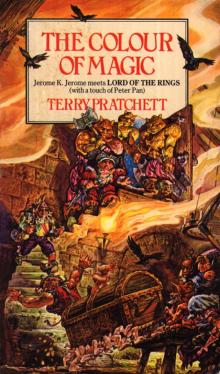 The Color of Magic
The Color of Magic Thud!
Thud! Good Omens: The Nice and Accurate Prophecies of Agnes Nutter, Witch
Good Omens: The Nice and Accurate Prophecies of Agnes Nutter, Witch I Shall Wear Midnight
I Shall Wear Midnight Mort
Mort Raising Steam
Raising Steam Guards! Guards!
Guards! Guards! Equal Rites
Equal Rites A Hat Full of Sky
A Hat Full of Sky The Light Fantastic
The Light Fantastic Mrs Bradshaw's Handbook
Mrs Bradshaw's Handbook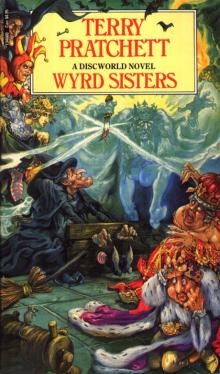 Wyrd Sisters
Wyrd Sisters Soul Music
Soul Music Small Gods
Small Gods Sourcery
Sourcery Reaper Man
Reaper Man Night Watch
Night Watch Lords and Ladies
Lords and Ladies The Fifth Elephant
The Fifth Elephant Monstrous Regiment
Monstrous Regiment The Truth
The Truth Witches Abroad
Witches Abroad Eric
Eric Going Postal
Going Postal Men at Arms
Men at Arms Jingo
Jingo The Amazing Maurice and His Educated Rodents
The Amazing Maurice and His Educated Rodents The Wee Free Men
The Wee Free Men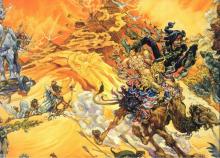 Pyramids
Pyramids Wintersmith
Wintersmith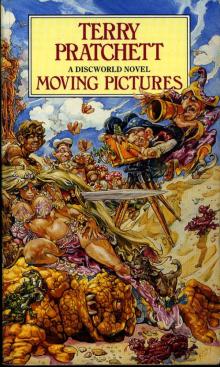 Moving Pictures
Moving Pictures Carpe Jugulum
Carpe Jugulum Interesting Times
Interesting Times Maskerade
Maskerade Making Money
Making Money The Shepherd's Crown
The Shepherd's Crown Hogfather
Hogfather Troll Bridge
Troll Bridge The Last Continent
The Last Continent The Sea and Little Fishes
The Sea and Little Fishes Snuff
Snuff Unseen Academicals
Unseen Academicals Guards! Guards! tds-8
Guards! Guards! tds-8 Jingo d-21
Jingo d-21 Turtle Recall: The Discworld Companion ... So Far
Turtle Recall: The Discworld Companion ... So Far The Fifth Elephant d-24
The Fifth Elephant d-24 Discworld 39 - Snuff
Discworld 39 - Snuff The Long War
The Long War Only You Can Save Mankind
Only You Can Save Mankind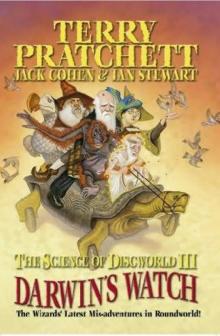 The Science of Discworld III - Darwin's Watch tsod-3
The Science of Discworld III - Darwin's Watch tsod-3 A Blink of the Screen: Collected Short Fiction
A Blink of the Screen: Collected Short Fiction Unseen Academicals d-37
Unseen Academicals d-37 Wings
Wings Making Money d-36
Making Money d-36 A Blink of the Screen
A Blink of the Screen Johnny and the Bomb
Johnny and the Bomb Dodger
Dodger Strata
Strata Discworld 02 - The Light Fantastic
Discworld 02 - The Light Fantastic The Folklore of Discworld
The Folklore of Discworld The Science of Discworld
The Science of Discworld The Unadulterated Cat
The Unadulterated Cat Raising Steam: (Discworld novel 40) (Discworld Novels)
Raising Steam: (Discworld novel 40) (Discworld Novels) The World of Poo
The World of Poo Discworld 05 - Sourcery
Discworld 05 - Sourcery The Witch's Vacuum Cleaner: And Other Stories
The Witch's Vacuum Cleaner: And Other Stories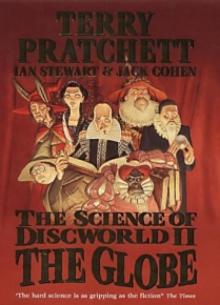 The Science of Discworld II - The Globe tsod-2
The Science of Discworld II - The Globe tsod-2 Small Gods: Discworld Novel, A
Small Gods: Discworld Novel, A Men at Arms tds-15
Men at Arms tds-15 Tama Princes of Mercury
Tama Princes of Mercury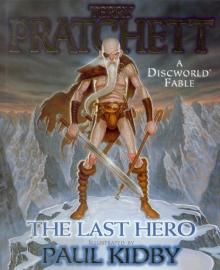 The Last Hero (the discworld series)
The Last Hero (the discworld series) The Long Utopia
The Long Utopia Discworld 03 - Equal Rites
Discworld 03 - Equal Rites Terry Pratchett - The Science of Discworld
Terry Pratchett - The Science of Discworld The Long Earth
The Long Earth The Carpet People
The Carpet People The Sea and Little Fishes (discworld)
The Sea and Little Fishes (discworld) The Colour of Magic
The Colour of Magic Discworld 16 - Soul Music
Discworld 16 - Soul Music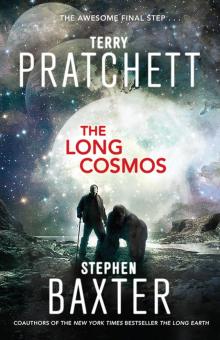 The Long Cosmos
The Long Cosmos The Dark Side of the Sun
The Dark Side of the Sun Monstrous Regiment tds-28
Monstrous Regiment tds-28 The Bromeliad 3 - Wings
The Bromeliad 3 - Wings Dragons at Crumbling Castle: And Other Stories
Dragons at Crumbling Castle: And Other Stories Night Watch tds-27
Night Watch tds-27 The Science of Discworld I tsod-1
The Science of Discworld I tsod-1 The Bromeliad 1 - Truckers
The Bromeliad 1 - Truckers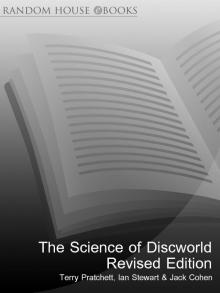 The Science of Discworld Revised Edition
The Science of Discworld Revised Edition The Abominable Snowman
The Abominable Snowman Father Christmas’s Fake Beard
Father Christmas’s Fake Beard The Bromeliad Trilogy
The Bromeliad Trilogy A Slip of the Keyboard
A Slip of the Keyboard The Wee Free Men d(-2
The Wee Free Men d(-2 Johnny and the Dead
Johnny and the Dead Mrs Bradshaw's Handbook (Discworld Novels)
Mrs Bradshaw's Handbook (Discworld Novels)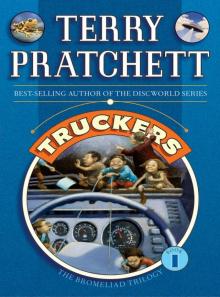 Truckers
Truckers The Amazing Maurice and His Educated Rodents d(-1
The Amazing Maurice and His Educated Rodents d(-1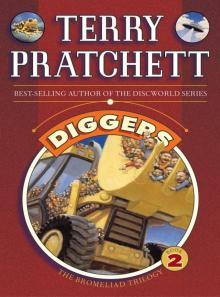 Diggers
Diggers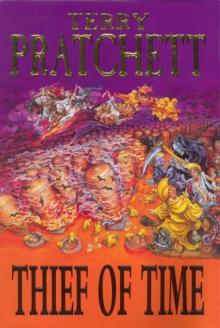 Thief of Time tds-26
Thief of Time tds-26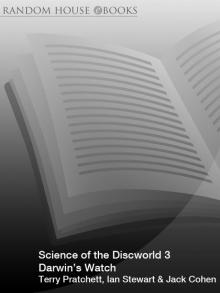 Science of Discworld III
Science of Discworld III Dragons at Crumbling Castle
Dragons at Crumbling Castle Nation
Nation Darwin's Watch
Darwin's Watch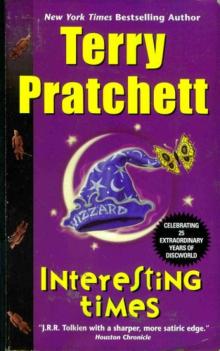 Interesting Times d-17
Interesting Times d-17 The Bromeliad 2 - Diggers
The Bromeliad 2 - Diggers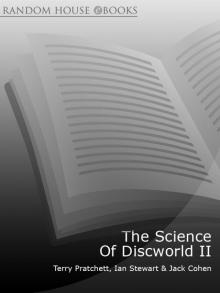 The Science of Discworld II
The Science of Discworld II